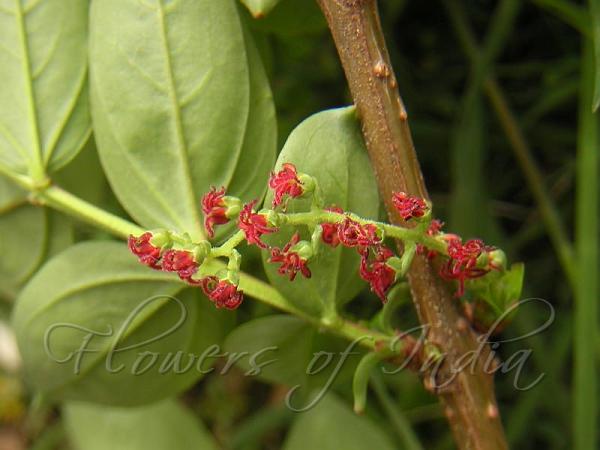|
| Masuri Berry |
|

|

| File size | 71298 |
| Original date | 4/9/11 11:23 AM |
| Resolution | 800 x 600 |
| Flash | Flash did not fire, auto |
| Focal length | 7.6mm |
| Exposure time | 1/246s |
| Aperture | 3.3 |
| Focus Distance | |
| Metering Mode | Multi-segment |
| Camera make | NIKON |
| Camera model | E2100 |
| Sensor type |
|
|
|
Photo: |
Botanical name: Coriaria napalensis Family: Coriariaceae (Coriaria family)
Synonyms: Coriaria kweichovensis, Coriaria sinica, Coriaria nepalensis
Synonyms: Coriaria kweichovensis, Coriaria sinica, Coriaria nepalensis
Masuri Berry is a large hairless shrub, 3-4 m tall, with arching
redish-brown branches. Legend has it that the hill station of Mussoorie got
its name from this shrub which grows in abundance there.
Elliptic pointed leaves are nearly stalkless and
noticeably 3-veined. Red flowers occur in several short clusters in leaf
axils. The five petals are greenish and smaller than the sepals. But
they soon enlarge to become fleshy. Prominent stamens and
style protrude out of the flower, and give the purplish red color to the
flowers. Fruit is black, with carpels encircled by
larger persistent purple petals. Fruit is eaten raw as famine food or used
as a beverage. Great caution has to be taken since most parts of the plant,
including the seed, are very toxic. Masuri Berry is found from Pakistan
right through the Himalayas to Myanmar and China, usually at altitudes of
800-2700 m. Flowering: February-April.
| Identification credit: Amit Chauhan | Photographed in Kalatope-Khajjiar Wildlife Sanctuary, Chamba, Himachal Pradesh & Rajouri, J&K. |
• Is this flower misidentified? If yes,